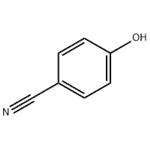Unveiling 4-Cyanophenol: A Tale of Chemistry, Applications, and Beyond
Oct 21,2024
4-Cyanophenol, also known as p-hydroxybenzonitrile, is an organic compound with the chemical formula C7H5NO. It is an important intermediate in the synthesis of various pharmaceuticals, agrochemicals, and specialty chemicals. 4-Cyanophenol is a precursor for the synthesis of a vasodilator, Levcromakalim.Bromination of 4-cyanophenol results in bromoxynil, a commercial herbicide.It can also be used as a component of deep eutectic solvent (DES) mixture.

Extraction and Separation Technologies
In the field of green and sustainable chemistry, 4-cyanophenol has attracted much attention for its role in the development of solvent impregnated resins (SIRs) for the separation of phenolic compounds from water. Extractants such as triisobutylphosphine sulfide (TIBPS), tributylphosphate (TBP), and tri-n-octylphosphine oxide (TOPO) have been investigated for their ability to form complexes with phenols including 4-cyanophenol, effectively removing them from aqueous solutions. These SIRs exhibit high selectivity and solubility, making them potential alternatives to conventional extractants for the removal of phenol at concentrations below 1 g/L.
Photophysics and photochemistry
The photophysical and photochemical properties of 4-cyanophenol have been explored in the context of coordination compounds. The photoinduced electron transfer (PCET) process of the Re(I) complexes with 4-cyanophenol has been studied in detail. These studies reveal the influence of the electronic excited state structure of the Re(I) complexes on the rate and mechanism of photoinduced PCET. These studies provide insights into the design of novel photoactive materials for various applications, including solar energy conversion and sensing.
Transition Metal-Catalyzed Etherification
4-Cyanophenol has also been implicated in transition metal-catalyzed etherification reactions, particularly in copper-catalyzed C-H bond oxidations. The compound has been used to synthesize diaryl ethers and alkoxylation products, demonstrating its versatility in organic synthesis. These reactions demonstrate the potential of 4-cyanophenol as a building block for constructing complex molecular structures.
4-Cyanophenol is a multifaceted compound with a wide range of applications in extraction, photochemistry, catalysis, and analytical chemistry.
- Related articles
- Related Qustion
1,7-Dimethylxanthine is a naturally occurring alkaloid compound that can enhance alertness and reduce drowsiness.....
Feb 27,2025APIThis paper reviewed the basic information, pharmacological effects, clinical applications, adverse reactions, contraindications of heparin sodium.....
Oct 21,2024API4-Cyanophenol
767-00-0You may like
- 4-Cyanophenol
-

- 2025-10-24
- CAS:767-00-0
- Min. Order:
- Purity: 0.99
- Supply Ability:
- 4-Cyanophenol
-

- $10.00 / 1KG
- 2025-10-21
- CAS:767-00-0
- Min. Order: 1KG
- Purity: 99%
- Supply Ability: 5tons
- 4-Cyanophenol
-

- $5.00 / 1KG
- 2025-09-25
- CAS:767-00-0
- Min. Order: 1KG
- Purity: 99%
- Supply Ability: g-kg-tons, free sample is available






